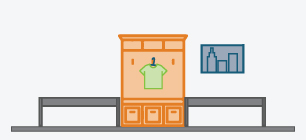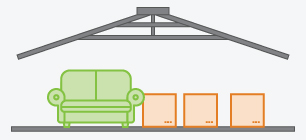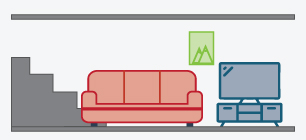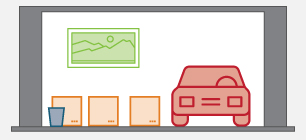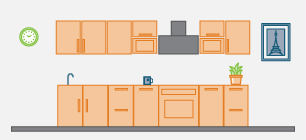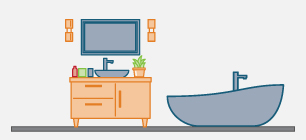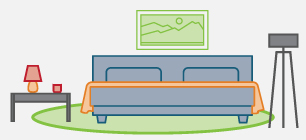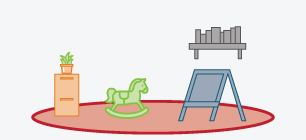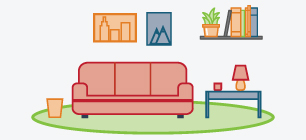Home Organization Ideas: A Room-by-Room Guide

We all have times in our lives when clutter can overwhelm our homes. From emotional overwhelm to a lack of time, even the most organized people can struggle to keep areas tidy. With our quick and simple organization tips for your home and help from certified professional organizers, you can cut down on the clutter and control the chaos.
7 Essential Home Organization Rules for Beginners
It’s easy to feel overwhelmed and not know where to start when you’re a home-organizing beginner. Follow these seven simple rules to confidently tackle your organization job and keep your home tidy.
1. Create a Plan
When it comes to organization, it’s easy to want to jump into your project head-first, but this can cause you to burn out faster than you think. Create a plan for your organizing job first, outlining specific goals and a timeline.
A checklist can help motivate you to complete your task. Start by outlining all the rooms you’d like to clean and then create a plan or list of tasks to accomplish in each room.

“Pick a room that does not involve hard decisions. For example, if you love to cook and need to declutter the kitchen, or if you have a hard time letting go of clothes even when they do not fit, do not start in either of these places. It's about building momentum first.”
2. Find Storage Solutions
It’s hard to organize your home when there’s nowhere for your stuff to go. Make sure there’s a place for your items and you have the right materials to keep everything organized. If you know things are just going to pile up in a tote, don’t buy it. Try to find storage solutions that will keep you organized and work with your lifestyle.

“Another great tip is to purchase containment that makes full use of your space. We see it all the time, clients have purchased their own bins and baskets in hopes of getting organized and they have subdivided their space by using too small bins that don't make full use of the shelf space.”
3. Think Outside the Box (or Storage Bin)
Remember, there aren’t any strict rules when it comes to home organization. Find storage solutions that work for you and your style, even if they’re unconventional. Galvanized bins are great storage solutions if you’re into a farmhouse look. For eclectic or traditional styles, consider antique furniture that could support your storage needs. Apothecary cabinets and old library catalog cabinets suit your style and hide your stuff at the same time.
4. Set a Time Limit
Don’t overwhelm yourself trying to organize your home in one day. On average, most rooms will take multiple days to fully organize. Break down your project into a manageable timeline. This is especially true if you’re trying to organize an emotionally taxing room, like an office or bedroom.
5. Take a Step Back (Live in the Space)
Organizing a space you’re unfamiliar with can be challenging. If you’re having a hard time understanding where your belongings go in a space, take a step back and live in the space. Give yourself time to understand how the room functions so you can organize it according to how you live your life. This is especially great for rooms you’re “working” in, like your kitchen.

“We always offer client breaks and discuss decision fatigue. We notice decision fatigue with almost all of our clients, especially when items have emotional or sentimental significance. To mitigate this, we offer breaks to our clients during the decluttering phase. Sometimes they are overwhelmed with the emotional process related to their own clutter and sometimes there is a sense of shame about their clutter. We give clients breaks so we do not overwhelm them emotionally with the process and allow them some time between decisions so they return refreshed."
6. Reassess as Your Needs Change
Your home is meant to grow with you. Ensure your home is changing as you do by auditing your organization needs every so often. Does the way your home is organized still serve you? If not, it may be time to reorganize.

“I define the vision and function of each room. Once you have a clear vision, you can determine what belongs in each space and what needs its own designated "home" elsewhere. If your kitchen is cluttered with paperwork, tools, or crafts, it's time to set up specific places for these items to live. Disorder often stems from too many categories of things jumbled together in the same space."
7. Try Different Organization Methods
Not everyone can organize a home the same way. While most people are comfortable tackling things room by room, it may not work for your lifestyle. Another way to organize things is by category. Bifulco explains that this may be more efficient, especially if all your items are scattered throughout your home.

“If you are going to embark on the project of organizing your whole home, I would start category by category, rather than room by room. For example, start with all coats and jackets. Gather all of those items from every room of your home and once they are in a pile go through and decide which items to keep. Be sure to take your donations out to the car before the day is done! Once you have decided what to keep, designate a home for that whole category if possible. It is much easier to keep an inventory of what you own if you store all like with like.”
1. Enter Into a Clean Home With an Organized Mudroom
Mudrooms and front entryways are small spaces that create a big impression. It’s the first thing both you and your guests will see when walking into your home. This room can be tricky to organize because a lot of times there aren’t places for your items to go. You may need to create new locations for your items. Built-in or freestanding cabinets, benches, cubbies or hooks are a great way to store your items in a small space.
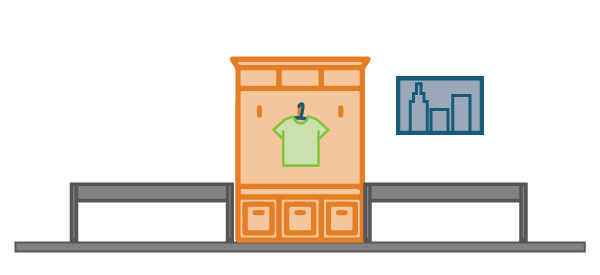
Mudroom Organization Tips
Rely on Open and Closed Storage: Mudrooms usually fall victim to the clutter you drop off when you enter your home. This includes jackets, shoes, keys, purses and pet items like leashes. Keep access to regularly used items by utilizing open storage, like hooks. Then, take less-used items and tuck them away in closed storage like drawers, totes or cubbies with covers.
Have Designated Drop Zones: Create a family-friendly mudroom where every member of the house has a place for their items. Rely on designated storage lockers, cubbies or hooks so that everyone can easily keep track of their belongings. This is great for jackets, shoes and backpacks.
Use a Bench or Window Seat: A bench with built-in storage is helpful for shoes. This way you can place your shoes inside the bench and then sit on it to put on and take off your shoes right by the door.
Maximize the Small Space: Sometimes you don’t have room for a bench, cubby or locker. If that’s the case, hanging hooks near your front door is a great option. Several furniture companies have created compact furniture items for small spaces.
Create Places for Small Items: Mudrooms and entryways always fall victim to the clutter of mail, keys and wallets. Keep clutter off your surfaces by coming up with a solution for these items, whether it be a drawer, hook or mail pouch on the wall.

“We love to use baskets and label them "drop things here." Then at the end of each day or week, depending on your schedule, we recommend everyone in the house pick a basket and put things away where they belong. If you have a new item, discuss together where it would practically make sense to store it.”
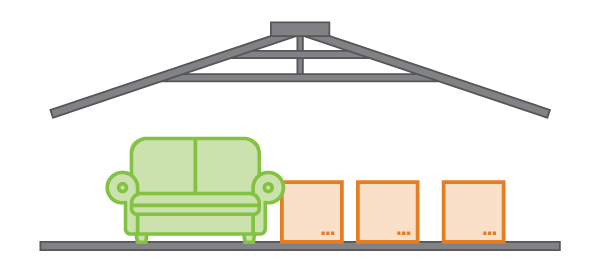
2. Make the Most of Attic Space
An attic can be one of the greatest storage spaces in a person’s home. It can also be one of the messiest. Half-filled boxes, holiday decorations and piles of unused items can add up quick. The good news is that organizing an attic is not as hard as you think. Follow these easy steps so everything you need is accessible and you’re not tripping over loose items every time you go up there.
Attic Organization Tips
Use and Label Containers: Attics are a catch-all storage space and a great location to store seasonal items, like decorations. Buy large totes and clearly label them with the items inside. For example, Christmas decorations, swimsuits and towels or sentimental items. Make the labels clearly visible. This way, when it comes time to retrieve your items, you can easily find and access them. Then, you also have a place for these items when the season is over.
Utilize Hard-to-Access Areas: There are some items that rarely leave the attic but are still important to us. Store these items in the less-accessible areas in your attic, and leave the easier-to-access locations for more popular materials, like decorations.
Hang Smaller Items: Most attics have rafters that go unused for storage. Hang small items like wreaths, lights or tools to maximize your storage space.
3. Tame an Unruly Basement
For some, having a basement is a blessing. For others, it’s a curse. While basements provide a lot of extra storage space, they can become a dumping ground for all the stuff you never get around to organizing. Or, they may fall victim to flooding depending on where you live. If your basement is cluttered, adopt these home organization ideas to tame the mess.
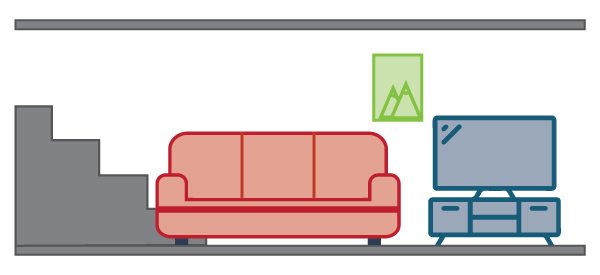
Basement Organization Tips
Use Shelves: Take advantage of vertical storage by purchasing shelving units. This way, you can store all your totes and other odds and ends in one place. Built-ins are great for heavier items, while free-standing shelving can be used for small or light items.
Store Items Under the Stairs: Using the space under the stairs is ideal for items you don’t need that often. Or, you can get creative and turn the space into a closet. If you have an open staircase, use curtains to hide the clutter.
Make Pegboards: Mount pegboards on your walls and paint them whatever color you like to match your basement. Use them to store smaller items, like tools.
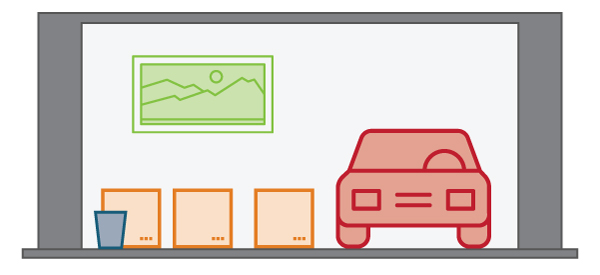
4. Get Control of Your Garage
According to the U.S. Department of Energy, 36% of people with two-car garages don’t have room to park inside. Additionally, 32% only have room for one car. If you fall in this category, it’s time to organize your garage. This doesn’t mean you have to find a new home for everything else you have stored there. Get your garage organized in no time by following these helpful home organization tips:

“When organizing a garage, pull everything out first and sort in the driveway if possible. We find decades of items stored in garages and only working parts of the garage will not produce a significant impact. If a client is among the many Americans unable to store a car in the garage, this is especially important because in order to get a car in, many items will need to be discarded or stored elsewhere.”
Garage Organization Tips
Create Storage Zones: Garages are a catch-all space for a variety of items, including lawn maintenance supplies, toys, chairs, extra kitchen storage and more. Create different zones throughout your garage so that everything has a designated location. If you’re running out of room, move some items to a spare shed. Whatever you choose, make sure your solution is functional for your lifestyle.
Use Specific Garage Hooks: If you need vertical storage for items like brooms, shovels, tools and more, you’re in luck. A lot of companies make storage solutions specifically for these items. Get pegboards, or garage-specific hooks to easily create a home for all your items.
5. Step Up Your Stairs Organization
For a lot of homes, stairs can be a clutter magnet. Since they’re usually by the front door, they can easily become an unwanted storage space for shoes, coats and anything that needs to go upstairs. Use these tips to keep your stairs clear, so you can walk up them without stepping over clutter.

Stairs Organization Tips
Place Baskets on Lower Steps: Putting down baskets is a great way to keep items that need to be moved upstairs confined to one location. This way, items aren’t sprawled across your steps making it dangerous to walk. Assign one basket to each household member so they know they’re responsible for taking the items up to where they belong.
Create Storage Solutions Near Your Staircase: Prevent your stairs from becoming a catch-all area by creating other storage solutions nearby. Installing hooks, a closet or adding a dresser for items that don’t belong on the stairs will help keep the area clear.
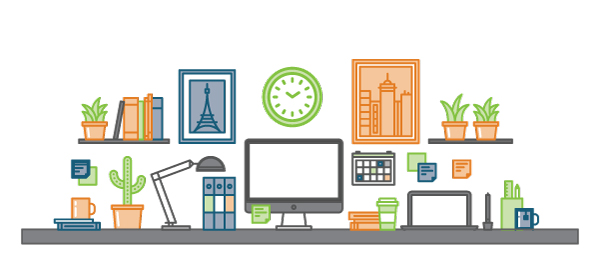
6. Avoid Distractions With a Clean Home Office
A cluttered home office can really slow you down, especially if you’re trying to run a business or pay the bills. While it’s easy to overlook this room compared to other areas of your home, organizing your office is essential for improving productivity. Get rid of that distracting mess by using these tips to organize your home office.
Home Office Organization Tips
Purge Unnecessary Paper: So much of the world is digital now that paper is almost obsolete! While some paper documents are essential, those should usually be kept in a safe or fireproof lockbox. Other important documents, like bank statements, are usually available in digital form. Confidently tackle office clutter by tossing the paper copies of these items.
“Over time, my husband and I get various paper statements (not bills), I’ll look to see if they have an option to switch to email statements. There are also various ways to get yourself off mailing lists.”
Create a Filing and Mail Station: Create a place for necessary paper items, like incoming or outbound mail and important files. File it as soon as you can, and then dedicate a time weekly to go over the items.
Make a Printing Station: If you have a printer, create a designated zone for it and all your materials. This includes extra paper, cardstock, ink and other materials. You can even keep necessary paper items, like bills and mail, nearby.
Use In-Drawer Containers: Office drawers can quickly become junk drawers after they’re overwhelmed with small supplies, like paper clips, pushpins, pens and more. Keep these items organized by using baskets, trays and bins.
Organize Books and Binders: Organize your books by color, author, genre or title to create an easy way to find what you’re looking for. Add in binders of organized paper materials too.
Get Digitally Organized: Office clutter isn’t just physical objects, it can also be old files and photos on your computer. Follow the advice from Amanda Jefferson and get organized by finding the biggest priority items based on your lifestyle.

“I like to think of digital clutter in terms of the Big Four: email, files, photos, and passwords. But instead of trying to tackle the Big Four all at once, start by working on the one area causing the most friction or the one project that is the highest priority.
By starting small on one project, you can get a quick win and some momentum. Then you can continue tackling that same area or move on to another one of the Big Four."
Sync Devices to The Cloud: Once you’ve scanned important photos and documents into your computer, it’s important to make sure they’re both safe from damage and easily accessible. Upload your important documents to a shared cloud so that they’re easily accessible on any device for those that need them.

”The most important first step is to make sure that everything is being synced with the cloud. I tell all of my clients that I want to be able to "throw their devices in the river," meaning that we could immediately access all of their important files and photos even if something happens to their devices.
And lastly, make sure to pin your favorite folders to the sidebar in Finder or Windows Explorer so that you can easily navigate to the files you use the most.”
7. Kitchen
Your kitchen is one of the most utilized areas of the home. Many people cook or prepare a meal in the kitchen daily or use it as a gathering place while hosting. Make sure you keep this area clean and functional so you can work efficiently. Use the following tips to make your kitchen an easy place to work.
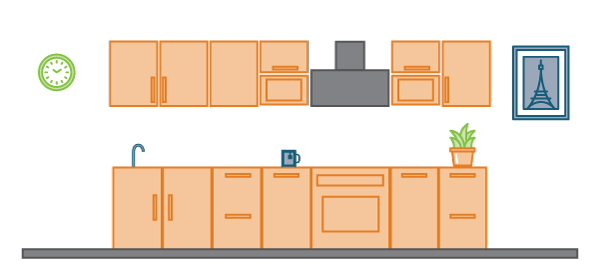
Kitchen Organization Tips
Place Items Strategically: Think about how you work in your kitchen. Do you need oven mitts near your oven and stovetop? What about utensils near your plates? Once you know how you operate in your kitchen, move items to where they’re easiest to access and put away.
Create Zones: A kitchen is another space where a lot is going on. You need storage for food, tools, plates, utensils and more. Create dedicated areas for similar items, like a coffee bar, or a place for all your kitchen gadgets. Because the kitchen is a high-traffic area, it can often collect a lot of items from other places in the house. Malowitz suggests creating smart solutions to clear visual clutter.

“Mail and school papers tend to get dropped on the kitchen counter, so having a bin nearby to drop these in creates less visual clutter; then set a time daily or weekly to go through these, thus creating a system of addressing these items.”
Use Lazy Susans and Drawer Dividers: It can be hard to see what’s hiding in the back of drawers and kitchen cabinets. Use organization tools, like lazy Susans, to make every item in your kitchen accessible and keep your [counters decluttered](^/blog/how-to-declutter-kitchen counters) for good.
8. Bathroom
Bathrooms can be a challenge to organize, especially when they’re filled with cleaning supplies or beauty products that you “might use one day.” It can be hard to find a place for everything, particularly in small bathrooms. Keep your bathroom organized with the tips below.
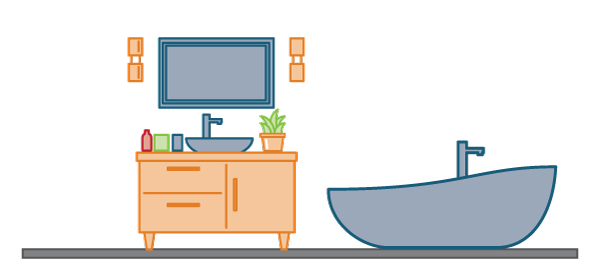
Bathroom Organization Ideas
Manage Your Medicine Cabinet: It’s easy for your medicine cabinet to become a storage spot for extra items and outdated prescriptions. Anyone else fall victim to having three boxes of opened Band-Aids? Audit your medicine cabinet items and consolidate similar materials into one storage location. If you have a large amount of one item, like cold medicine or Tylenol, move it to a utility closet. This way, you can create space for items that have been sitting on your countertop.
Add Towel Storage: If your towel rack isn’t big enough for everyone, it’s time to install hooks in the bathroom. Hooks are an inexpensive way to ensure towels don’t end up on the floor smelling musty.
Reclaim the Space Over the Toilet: Adding shelving above the toilet can create a ton of extra storage. This is especially great for small bathrooms. Fill the shelves with toiletries, towels or even decor to add character to the space.
Use Apothecary Jars for Storage: Apothecary jars are a great way to add functional style to your bathroom. These clear glass jars can be used to store bath salts, sponges, cotton balls and more. Plus, they can be stored openly, since they’re usually stylish.
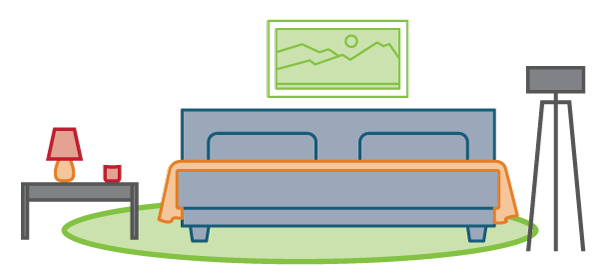
9. Bedroom
Keeping a bedroom organized is essential to finding the right items when you need them, from seasonal clothing and makeup to other odds and ends. Use these creative storage solutions and other tips to maintain a functional, relaxing and clutter-free bedroom.
Bedroom Organization Tips
Use Totes and Baskets: Totes and baskets can help store seasonal items that you aren’t wearing year-round. Place things like bulky sweaters or jean shorts and tank tops in totes and stash them away on higher shelves to use when you need them. This can also free up storage in your drawers and dressers to use exclusively for basics that you wear all the time.
Store Things Under the Bed: Store items, like extra sheets, blankets, a heating pad or sentimental items, under your bed. This keeps your materials out of sight but still easily accessible for when you need them.
Color Coordinate Clothing: This is especially great for organizing your closet. This way, when you’re looking for that specific shirt you want to wear, and you know it’s green, you can limit your search to one section.

“For closets, I recommend sorting through them every few months. Try your clothes on and stand in front of the mirror. Our body shapes change, and so do the latest styles. It's easy for clothing to get out of rotation and exceed the boundaries of our closets."
Use Storage Furniture: If you’re running out of space, swap out some of your existing furniture for storage furniture. A good first replacement is your side table which may have only one small drawer or no drawers at all. Replace it with a three-drawer table to store items like socks and other small clothes.
Get Organizers for Small Items: Investing in a jewelry organizer or even an over-the-door shoe organizer keeps all your smaller items in place.
10. Playroom
While not everyone has a playroom, those that do know how crazy it can become. Creating storage solutions so simple a child can use them is essential. Use our kid-friendly tips to make a playroom as organized as it is fun.
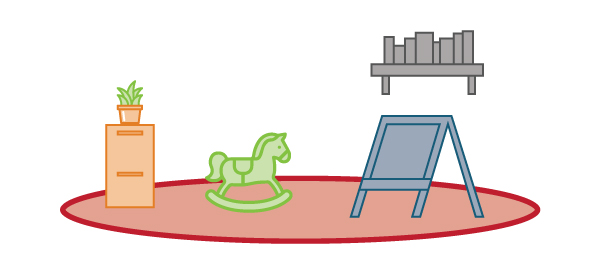
Playroom Organization Tips
Store Sentimental Toys: Is there a toy that your child doesn’t play with anymore, but you just can’t get rid of it because they used to love it? That’s OK! Just move the toy into storage. One option is to create a tote for these items and keep them in a storage area, like a basement or attic.
Think About Function: Think about how your child uses their toys, if they play with several items at once, like toy cars or blocks, keep them in a bucket where a large amount of them are accessible at once.
Keep Some Toys Out: It’s OK if your home isn’t sterile, especially if you have kids. Larger items that are played with one at a time can be left out and displayed.
Consider a Toy Rotation: If you’re truly running out of space, a toy rotation could help. This is where some toys get put away and some stay out, then you switch the items out every few weeks or months. This way, the toys will feel new and exciting to your children.

"We label in playrooms because this allows a more likely return of the toys to their home. Even with children too young to read, we will put labels on their bins with the word and also with a picture of the category. This has multiple benefits. At a young age, children will become a part of maintaining the organizational system. In addition, children begin to recognize letters associated with the picture, which is the beginning of the early stages of reading."
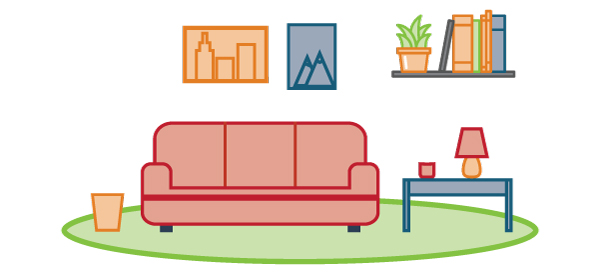
11. Living Room
A living room is another one of those spaces that collect clutter from other areas of the house. Because it’s a common gathering space for friends and family members, you may find your space filled with papers, toys, electronics, blankets, books and more. Use our tips to keep your living room organized and looking like a picture from a magazine.
Living Room Organization Tips
Buy Furniture With a Purpose: Sometimes, the best furniture pieces are ones that are both stylish and functional. If you need extra storage in your living room, try to find coffee tables and couches with built-in storage. To keep a clean look, buy pieces that have closed storage. This way, you can keep necessary items nearby without worrying about guests seeing them.
Take Advantage of Hidden Spaces: It’s easy to have wasted space in your living room, like behind the couch or other large furniture pieces. Take advantage of hidden space to store things you use less frequently, like extra pillows and blankets.
Reconsider Your Space’s Function: Rooms can often collect clutter from other areas of the home when we’re not using them properly. Are you finding a lot of papers and books piling up in your living room? It might be time to address how your space is being used. Try combining your spaces by adding a bookshelf or desk to create a space between an office and living room.
Home Organization FAQs
What's the best way to organize a room?
Start with open, visible areas like floors, then other horizontal surfaces, like countertops. Once you’ve completed those, move on to drawers, closets and other storage areas.

“Pick a corner, a cabinet or a drawer and get started. Try to finish each room before moving on to the next room but if you are decluttering one area because something belongs somewhere else in the home, move it to that space. The trick is to go back to the space you were in and keep going before starting on a new space.”
How much does home organization cost?
The cost of home organization depends on your project, what supplies you need and if you’re hiring a professional. Small hour-long projects can cost $0 to $200. If you’re working on a bigger decluttering project with a professional, you can expect to pay $30 to $150 per hour.
When should I hire a home organizer?
When you’re approaching a home organization project, sometimes working with a professional is your best option. Whether you’re emotionally overwhelmed or don’t know where to start, a professional organizer can help. Plus, working with an organizer isn’t as scary as it seems. Usually, they work with you and ask about your organization-specific goals so they’re completing the tasks you find most helpful. Plus they’ll develop systems and storage solutions to keep the area tidy long term.
How do I organize my house when overwhelmed?
Create a plan of manageable tasks before jumping in. Then, start a small project that’s easy to finish so you feel a sense of accomplishment. Then continue your tasks, breaking them up based on your timeline, until you’re finished.
2 Tips to Keep Your Home Organized
It's always easier to keep a home clean and decluttered when you have systems in place that make it easy. Use the following tips to ensure your home never becomes disorganized again.
1. Use the 1-in-1-Out Rule
Reduce the overall clutter in your home before it becomes too much by using this rule. When you bring a new item into your home, get rid of an old one. This way, the new object already has a place within your home.

“A great rule of thumb is the 1-in-1-out rule. If you have a new item come into the home, it's good to let go of something similar in size or usage. This way the clutter does not pile up. If you feel behind in keeping up with this, I always suggest the 1-in-2-out rule.”
2. Be Intentional About Your Belongings
Make sure the items you’re keeping in your house have a purpose, whether the items are functional and you use them regularly, or they just make you happy. All items you own should be helpful in some way. If they aren’t, it might be time to let go.

“If you constantly find organization to be a chore, the simplest solution is to eliminate excess in your life until you find a balance. Simplifying your belongings can make a huge difference in how manageable and enjoyable your space feels.”
Relax in Your Organized Home
Now that your home is organized, enjoy it! It’s time to relax in your new organized space. Just remember to keep everything in its place. And, if your needs change, you can always reorganize.

